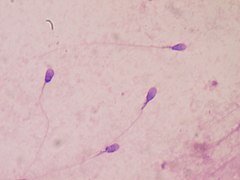
Back تنافس المني Arabic Spermienkonkurrenz German Spermokonkurenco Esperanto رقابت اسپرم Persian Compétition spermatique French Kompetisi sperma ID Competição espermática Portuguese Конкуренция сперматозоидов Russian Spermiekonkurrens Swedish Kamikaze sperm Turkish


Sperm competition is the competitive process between spermatozoa of two or more different males to fertilize the same egg[1] during sexual reproduction. Competition can occur when females have multiple potential mating partners. Greater choice and variety of mates increases a female's chance to produce more viable offspring.[2] However, multiple mates for a female means each individual male has decreased chances of producing offspring. Sperm competition is an evolutionary pressure on males, and has led to the development of adaptations to increase male's chance of reproductive success.[3] Sperm competition results in a sexual conflict between males and females.[2] Males have evolved several defensive tactics including: mate-guarding, mating plugs, and releasing toxic seminal substances to reduce female re-mating tendencies to cope with sperm competition.[4] Offensive tactics of sperm competition involve direct interference by one male on the reproductive success of another male, for instance by mate guarding or by physically removing another male's sperm prior to mating with a female.[5][6] For an example, see Gryllus bimaculatus.
Sperm competition is often compared to having tickets in a raffle; a male has a better chance of winning (i.e. fathering offspring) the more tickets he has (i.e. the more sperm he inseminates a female with). However, sperm are not free to produce,[7] and as such males are predicted to produce sperm of a size and number that will maximize their success in sperm competition. By making many spermatozoa, males can buy more "raffle tickets", and it is thought that selection for numerous sperm has contributed to the evolution of anisogamy with very small sperm (because of the energy trade-off between sperm size and number).[8] Alternatively, a male may evolve faster sperm to enable his sperm to reach and fertilize the female's ovum first. Dozens of adaptations have been documented in males that help them succeed in sperm competition.
- ^ Parker, Geoffrey A. (1970). "Sperm competition and its evolutionary consequences in the insects". Biological Reviews. 45 (4): 525–567. doi:10.1111/j.1469-185x.1970.tb01176.x. S2CID 85156929.
- ^ a b Stockley, P (1997). "Sexual conflict resulting from adaptations to sperm competition". Trends Ecol. Evol. 12 (4): 154–159. doi:10.1016/S0169-5347(97)01000-8. PMID 21238013.
- ^ Wedell, Nina; Gage, Matthew J.G.; Parker, Geoffrey A. (2002). "Sperm competition, male prudence and sperm-limited females". Trends in Ecology & Evolution. 17 (7): 313–320. doi:10.1016/S0169-5347(02)02533-8.
- ^ Simmons, L.W (2001). Competition and its Evolutionary Consequences in the Insects. Princeton University Press. ISBN 978-0691059884.
- ^ Birkhead, T.R; Pizzari, Tommaso (2002). "Postcopulatory sexual selection" (PDF). Nat. Rev. Genet. 3 (4): 262–273. doi:10.1038/nrg774. PMID 11967551. S2CID 10841073.
- ^ Cite error: The named reference
bakerwas invoked but never defined (see the help page). - ^ Olsson et al., 1997; Wedell et al., 2002
- ^ Jiang-Nan Yang (2010). "Cooperation and the evolution of anisogamy". Journal of Theoretical Biology. 264 (1): 24–36. Bibcode:2010JThBi.264...24Y. doi:10.1016/j.jtbi.2010.01.019. ISSN 0022-5193. PMID 20097207.
© MMXXIII Rich X Search. We shall prevail. All rights reserved. Rich X Search